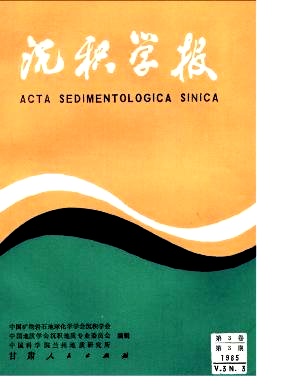TRACE FOSSILS ANP THEIR ENVIRONMENTAL SIGNI-FICANCE IN NON-MARINE TURBIDITE DEPOSITS FROM JIYUAN-YIMA BASIN,WESTERN HENAN
- Received Date: 1983-12-12
- Publish Date: 1985-09-10
Abstract: The paper covers eight families and ten species of trace fossils in the non-marine turbidite deposits of the Lower Jurassic age from the Jiyuan-Yima district, western Henan, among which two families and three species are new. And trace fossils of typical deep-water types such as Paleodictyon and Protopaleodictyon were discovered for the first time in fresh-water lake basins. It is of great significance to study non-marine ichnofacies model by means of the established marine ichnofacies model. Jiyuan flysch, which is between the Danaeopsis-Bernoullia flora of the Upper Triassic and Coniopteris-Phoenicopsis flora of the Middle Jurassic, is about 105m in thickness and is divided into upper, middle and lower parts. The three parts of the flysch consist of different types of ichnofossils, showing that the environment of Jiyuan-Yima fault basin changed rapidly due to the accumulatin of the sediments coming from the surrounding highland. The lower part of non-marine flysch is 18.3m thick, it contains 63 Bouma Sequences and is mainly composed of facies C. The grains becomes gradually coarse from below to above. The patterned trace fossils such as Paleodictyon, Protopaleodictyon may suggest that they were formed in a condition of sublacustrine middle fan and probably represented the deepest water period when sublacustrine turbidity was at its earliest stage of sedimentation. The middle part of the flysch consists of Facies B2 ,C,D and E. Its thickness is 60m, including 156 Bouma Sequences. The grains become finer and finer from below to above. Trace fossils are abundant and diversity is high. There are some important trace fossils such as Jiyuanichnus, Paracanthorhaphe, Tuberculichnus, Sa-bularia and Protopaleodityon. The tracemarkers were active in sublacustrine network-like channels, including that the development of lake basin approached its middle stage. There are 146 Bouma Sequences with 26.7m in thickness in the upper part of Ji-yuan Flysch. Most of them are of Pattern De and Ce. No other categories have been found except Granularia and Chondrites. The absence of deep-water forms and low diversity may be considered as an evidence of the ending of turbidite deposition. The analysis of paleocurrent within the Jiyuan-Yima Basin indicates that the sediments in the northeastern part, e.g. Jiyuan Area, originated from the southwest and southeast alternately. The main transportation direction of the sediments in southwestern basin, i.e. Yima Area was from southwest to northeast. The ephemeral development of Jiyuan turdidite deposits has been recorded both in ichnology and sedimentology. The records in ichnology may imply that the tracemarkers living in the sublacustrine were quite sensitive to the changing environment caused by the rapid sediment accumulation. Thus their traces are good indicators in determining subenviroments.
| Citation: | wuXiantao. TRACE FOSSILS ANP THEIR ENVIRONMENTAL SIGNI-FICANCE IN NON-MARINE TURBIDITE DEPOSITS FROM JIYUAN-YIMA BASIN,WESTERN HENAN[J]. Acta Sedimentologica Sinica, 1985, 3(3): 23-31. |






 DownLoad:
DownLoad: